Der Block-Editor in WordPress ist der Standard-Editor zum Schreiben von Inhalten und zum Editieren Ihrer Website. Er wurde 2019 mit dem Spitznamen Gutenberg eingeführt und ersetzte den alten klassischen Editor.
Der Block-Editor bietet eine einfache und intuitive Möglichkeit, Inhalte zu erstellen und Ihre WordPress-Website zu bearbeiten.
In diesem Tutorial zeigen wir Ihnen, wie Sie den WordPress-Block-Editor verwenden und ihn beherrschen, um visuell beeindruckende Blogbeiträge und Seiten zu erstellen.
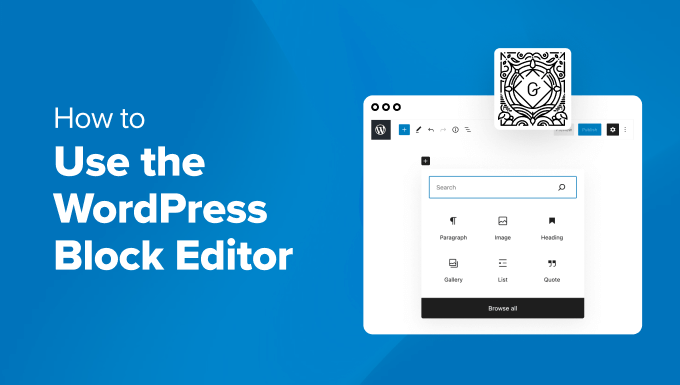
Was ist der Unterschied zwischen dem Block-Editor (Gutenberg) und dem klassischen Editor?
Bevor wir in den Block-Editor eintauchen, sollten wir die Unterschiede zwischen dem Gutenberg-Block-Editor und dem älteren klassischen Editor vergleichen und verstehen.
So sieht der klassische Editor in WordPress aus:
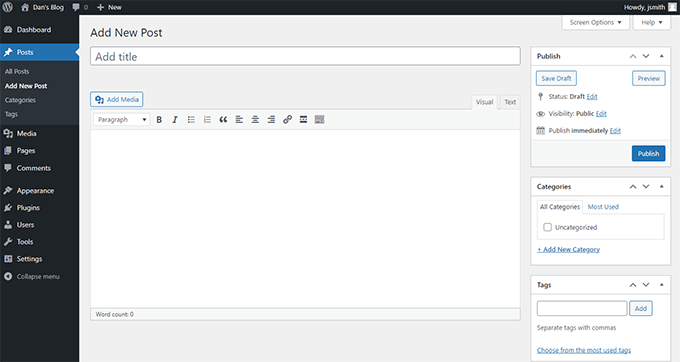
Es hatte ein Texteditor-Feld mit einigen grundlegenden Formatierungsoptionen. Die Funktionalität und das Erscheinungsbild waren recht begrenzt.
So sieht der Block-Editor in WordPress aus:
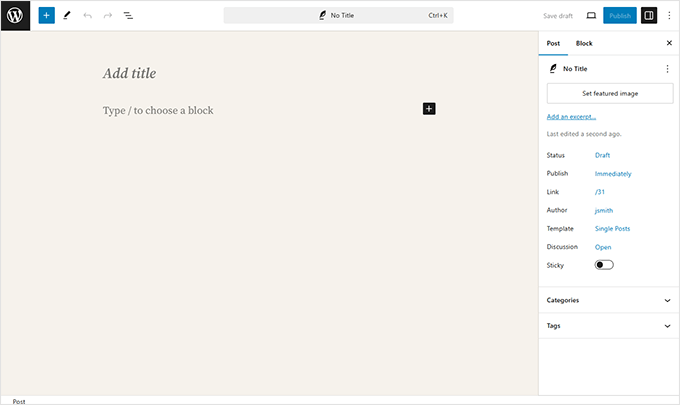
Wie Sie sehen können, handelt es sich um zwei völlig unterschiedliche Editoren für die Erstellung von Inhalten in WordPress.
Der alte klassische Editor war ein Texteditor mit Formatierungsschaltflächen ähnlich wie Microsoft Word.
Der neue Editor verwendet einen anderen Ansatz, der als „Blöcke“ bezeichnet wird (daher auch der Name Block-Editor).
Blöcke sind Inhaltselemente, die Sie auf der Bearbeitungsseite hinzufügen können, um Layouts zu erstellen. Jedes Element, das Sie zu Ihrem Beitrag oder Ihrer Seite hinzufügen, ist ein Block.
Sie können zum Beispiel Blöcke für Absätze, Bilder, Videos, Galerien, Audio, Listen und mehr hinzufügen. Es gibt Blöcke für alle gängigen Inhaltselemente, und weitere können durch WordPress-Plugins hinzugefügt werden.
Wie ist der WordPress-Block-Editor besser als der klassische Editor?
Der WordPress-Block-Editor bietet eine einfache Möglichkeit, verschiedene Arten von Inhalten zu Ihren Beiträgen und Seiten hinzuzufügen.
Wenn Sie z. B. bisher mit dem klassischen Editor eine Tabelle in Ihren Inhalt einfügen wollten, benötigten Sie ein separates Plugin für Tabellen.
Mit dem Blockeditor können Sie einfach einen Tabellenblock hinzufügen, Ihre Spalten und Zeilen auswählen und mit dem Hinzufügen von Inhalten beginnen.
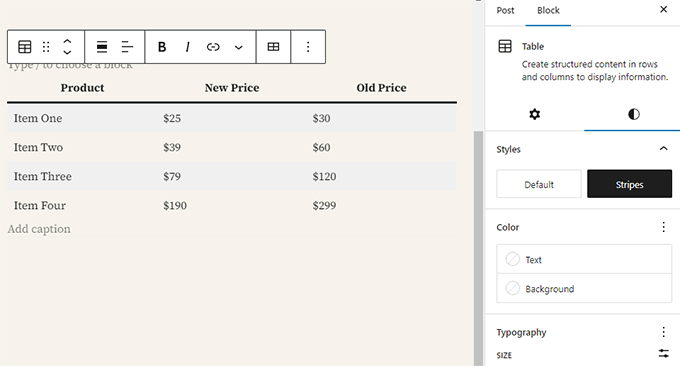
Sie können Inhaltselemente nach oben und unten verschieben, sie als einzelne Blöcke bearbeiten und auf einfache Weise medienintensive Inhalte erstellen.
Am wichtigsten ist, dass der WordPress-Block-Editor einfach zu bedienen und zu erlernen ist.
Dies ist ein immenser Vorteil für alle WordPress-Anfänger, die gerade ihren ersten Blog starten oder eine DIY-Geschäftswebsite erstellen.
Sehen wir uns also an, wie man mit dem Block-Editor von WordPress großartige Inhalte wie ein Profi erstellt.
Das werden wir in diesem Gutenberg-Tutorial behandeln:
- Using Gutenberg – The WordPress Block Editor
- Creating a New Blog Post or Page Using The Block Editor
- How to Add a Block in the Block Editor
- Working With Blocks in the New Editor
- Organizing Blocks in Groups and Columns
- Saving and Reusing Blocks in Gutenberg
- Publishing and Managing Options in Gutenberg Block Editor
- Plugin Settings in Gutenberg
- Adding Some Common Blocks in the Block Editor
- Exploring Other Content Blocks in the Block Editor
- Bonus Tips to Use Gutenberg Like a Pro
- Adding More Blocks to Gutenberg Block Editor in WordPress
- FAQs About Gutenberg – The Block Editor in WordPress
- Bonus Resources
Sind Sie bereit? Lasst uns eintauchen.
Video-Anleitung
Wenn Sie eine schriftliche Anleitung bevorzugen, dann lesen Sie einfach weiter.
Gutenberg verwenden – Der WordPress-Block-Editor
Der Block-Editor wurde so konzipiert, dass er intuitiv und flexibel ist. Er sieht zwar anders aus als der alte WordPress-Editor, bietet aber immer noch alle Funktionen des klassischen Editors.
Beginnen wir mit den grundlegenden Dingen, die Sie im klassischen Editor gemacht haben und wie sie im Block-Editor gemacht werden.
Erstellen eines neuen Blogbeitrags oder einer Seite mit dem Block-Editor
Sie erstellen einen neuen Blog-Beitrag oder eine neue Seite, wie Sie es normalerweise tun würden. Klicken Sie einfach auf das Menü Beiträge “ Neuen Beitrag hinzufügen in Ihrem WordPress-Admin. Wenn Sie eine Seite erstellen, wählen Sie stattdessen das Menü Seiten “ Neu hinzufügen.
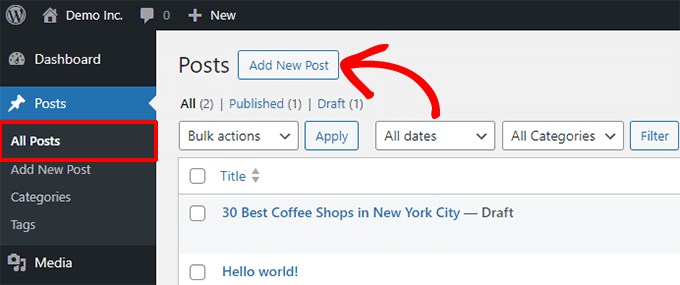
Dadurch wird der Blockeditor gestartet.
So fügen Sie einen Block im Block-Editor hinzu
Der erste Block eines jeden Beitrags oder einer Seite ist der Titel.
Sie können sich mit der Maus unter den Titel bewegen oder die Tabulatortaste auf Ihrer Tastatur drücken, um den Cursor nach unten zu bewegen und mit dem Schreiben zu beginnen.
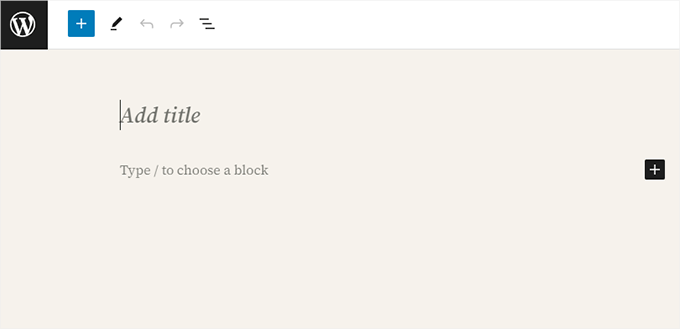
Standardmäßig ist der nächste Block ein Absatzblock. So kann der Benutzer sofort mit dem Schreiben beginnen.
Wenn Sie jedoch etwas anderes hinzufügen möchten, können Sie auf die Schaltfläche „Neuen Block hinzufügen“ [+] in der oberen linken Ecke des Editors, unter einem bestehenden Block oder rechts neben einem Block klicken.
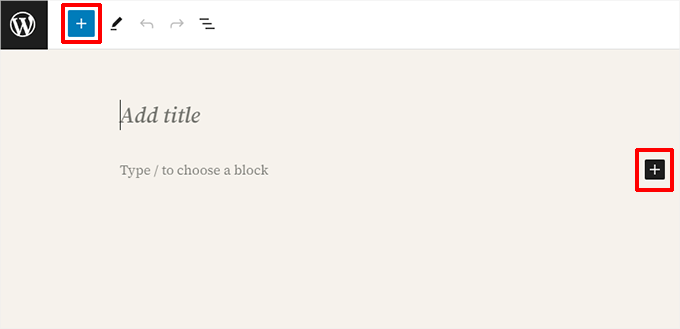
Wenn Sie auf die Schaltfläche klicken, wird das Menü „Block hinzufügen“ mit einer Suchleiste oben und häufig verwendeten Blöcken unten angezeigt.
Sie können auf Registerkarten klicken, um Blockkategorien zu durchsuchen, oder ein Stichwort eingeben, um schnell nach einem bestimmten Block zu suchen.
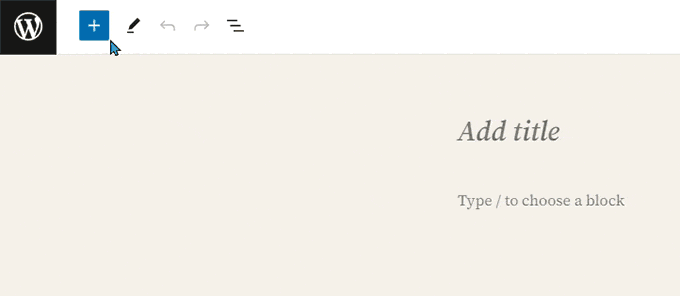
Wenn Sie nicht mit der Maus auf die Schaltfläche klicken möchten, können Sie auch ein Tastaturkürzel verwenden.
Beginnen Sie mit der Eingabe von /, um einen Block zu suchen, und fügen Sie ihn dann durch Drücken der Eingabetaste auf Ihrer Tastatur ein.
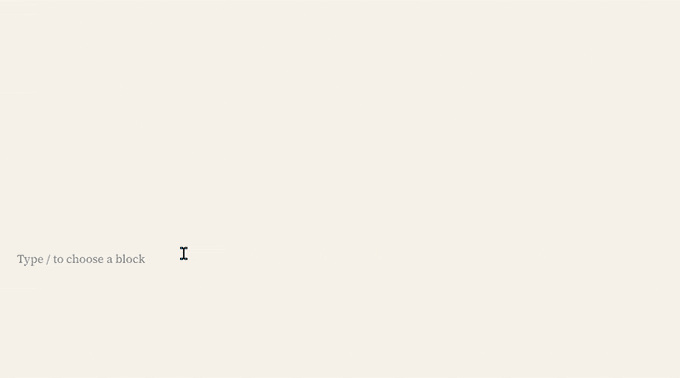
Arbeiten mit Blöcken im neuen Editor
Jeder Block hat eine Werkzeugleiste, die oben auf dem Block erscheint. Die Buttons in der Werkzeugleiste ändern sich je nach dem Block, den Sie bearbeiten.
In der Abbildung unten arbeiten wir beispielsweise an einem Absatzblock, der grundlegende Formatierungsschaltflächen wie Textausrichtung, fett, kursiv, Link einfügen und weitere Optionen zeigt, die unter dem Drei-Punkte-Menü verfügbar sind.
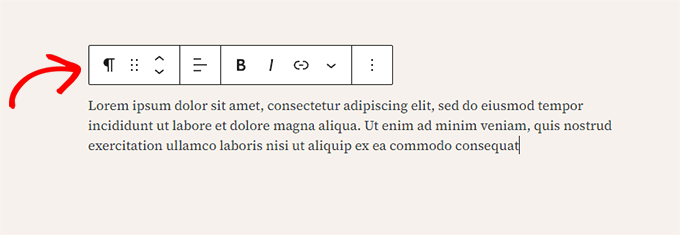
Zusätzlich zur Werkzeugleiste kann jeder Block seine eigenen Blockeinstellungen haben, die in der rechten Spalte der Ansicht erscheinen.
Diese Einstellungen variieren je nach dem Block, den Sie bearbeiten. Im Block „Absatz“ können Sie zum Beispiel die Text-, Hintergrund- und Linkfarbe sowie die Typografie bearbeiten.
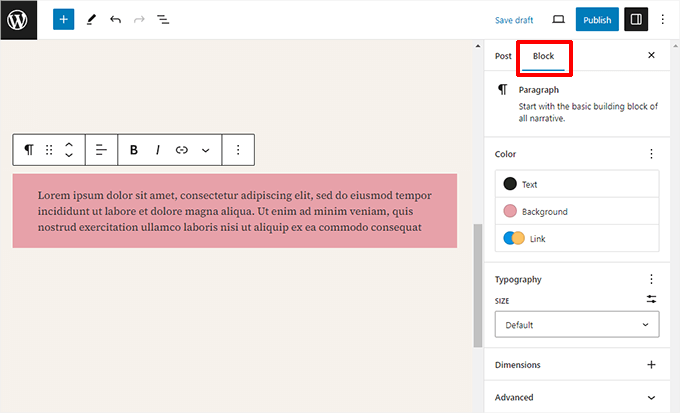
Du kannst Blöcke nach oben und unten verschieben und sie neu anordnen.
Wenn Sie dies tun möchten, klicken Sie einfach auf “ Ziehen“ oder „Ablegen“ oder auf die Schaltflächen „Nach oben“ und „Nach unten“ in der Blocksymbolleiste.
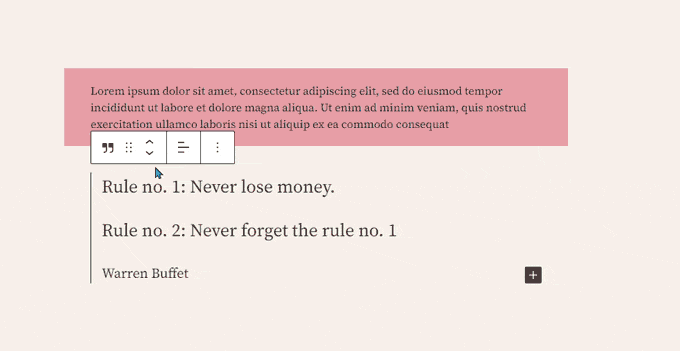
Verwandt: Siehe unsere Anleitung zum Entfernen eines Blocks in WordPress.
Organisieren von Blöcken in Gruppen und Spalten
Der Block-Editor verfügt außerdem über praktische Werkzeuge zur Verwaltung und Organisation Ihrer Inhaltslayouts.
Sie können mehrere Blöcke auswählen, indem Sie sie anklicken, während Sie die Umschalttaste auf Ihrer Tastatur gedrückt halten.
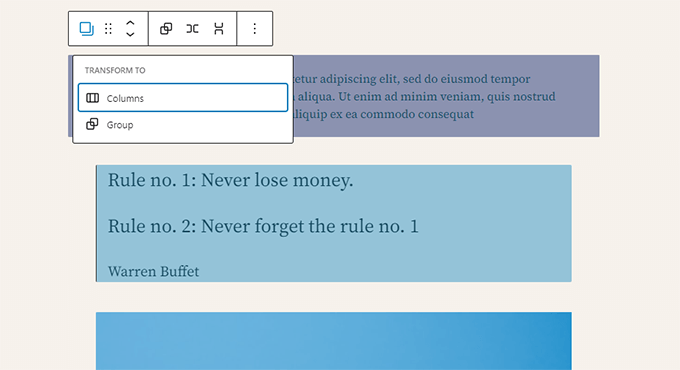
Klicken Sie anschließend auf die Schaltfläche Blocktyp in der Symbolleiste, um die ausgewählten Blöcke in Gruppen oder Spalten umzuwandeln.
Sie können dann Stile auf den gesamten Gruppenblock anwenden, z. B. die Ausrichtung oder die Abstände ändern.
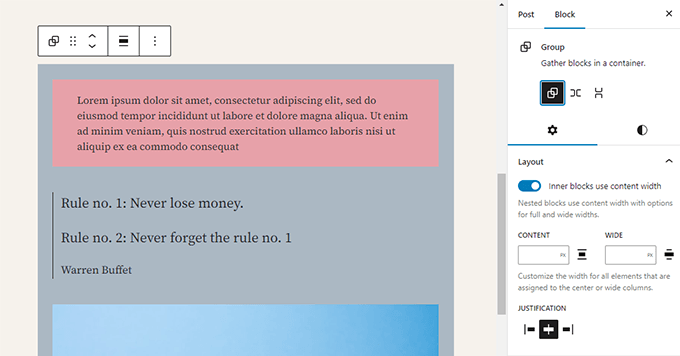
Mit dem Blockeditor können Sie auch einen leeren Gruppen- oder Spaltenblock hinzufügen.
Danach können Sie sie mit anderen Blöcken füllen.
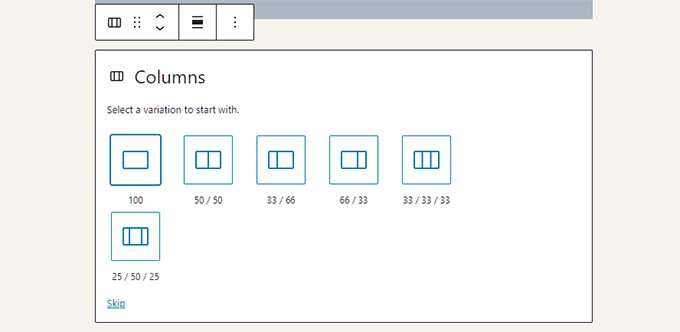
Sie können jede Art von Block in jeder Spalte nach Bedarf hinzufügen.
So können Sie schöne Layouts für verschiedene Anwendungsfälle erstellen.
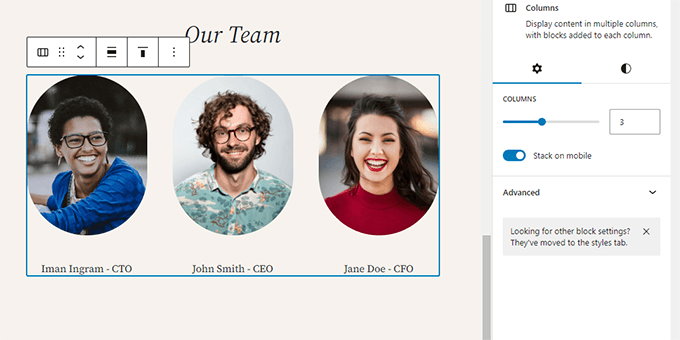
Speichern und Wiederverwenden von Blöcken in Gutenberg
Das Beste an der Verwendung von Blöcken ist, dass sie gespeichert und wiederverwendet werden können. Dies ist besonders hilfreich für Website-Betreiber und Blogger, die häufig bestimmte Inhaltsausschnitte zu ihren Artikeln oder Seiten hinzufügen müssen.
Klicken Sie einfach auf den Menü-Button in der rechten Ecke der Werkzeugleiste des jeweiligen Blocks. Wählen Sie im Menü die Option „Vorlage erstellen“.
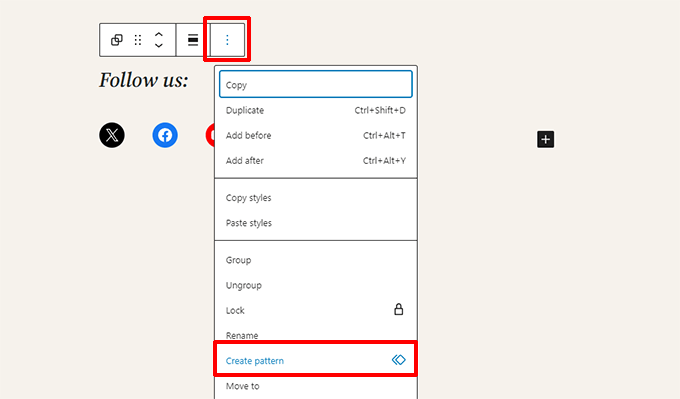
Hinweis: Sie können auch ganze Gruppen und Spalten als wiederverwendbare Blöcke verwenden. So können Sie ganze Abschnitte speichern und bei Bedarf wiederverwenden.
Daraufhin wird ein Popup-Fenster angezeigt, in dem Sie einen Namen für diese Vorlage angeben müssen. Dies kann ein beliebiger Name sein, mit dem Sie leicht erkennen können, wann Sie das Muster wiederverwenden müssen.
Dann können Sie optional Kategorien auswählen. So können Sie Ihre Muster übersichtlich sortieren.
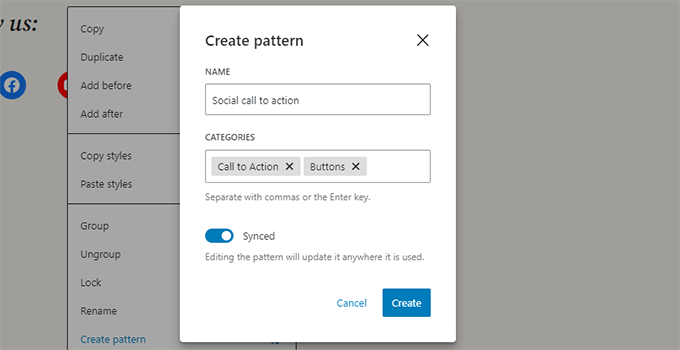
Klicken Sie anschließend auf die Schaltfläche „Erstellen“, um Ihr Muster zu speichern. WordPress speichert Ihr Muster mit allen darin enthaltenen Blöcken.
Um Ihr Muster wiederzuverwenden, bearbeiten Sie einfach den Beitrag oder die Seite, auf der Sie es hinzufügen möchten.
Klicken Sie dann auf die Schaltfläche [+] Block hinzufügen oder verwenden Sie das Tastaturkürzel /. Sie können das Muster finden, indem Sie den Namen eingeben, den Sie ihm gegeben haben.
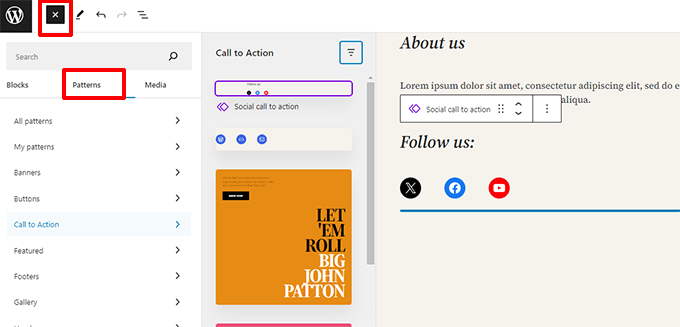
Vorlagen erleichtern Website-Besitzern das Hinzufügen häufig verwendeter Elemente zu ihren Layouts, z. B. Aufrufe zum Handeln, Buttons für soziale Medien, Banner und vieles mehr.
Ihr WordPress Theme oder Plugins bringen vielleicht sogar eigene Vorlagen mit, oder Sie finden Vorlagen, die von anderen erstellt wurden, in der WordPress Block Patterns-Bibliothek.
Wenn Sie mehr Hilfe benötigen, haben wir einen separaten Leitfaden für Anfänger zum Finden und Verwenden von WordPress-Blockvorlagen.
Veröffentlichen und Verwalten von Optionen im Gutenberg-Block-Editor
Jeder WordPress-Beitrag enthält eine Vielzahl von Metadaten. Dazu gehören Informationen wie das Veröffentlichungsdatum, Kategorien und Tags, vorgestellte Bilder und mehr.
Alle diese Optionen befinden sich übersichtlich in der rechten Spalte des Editor-Bildschirms.
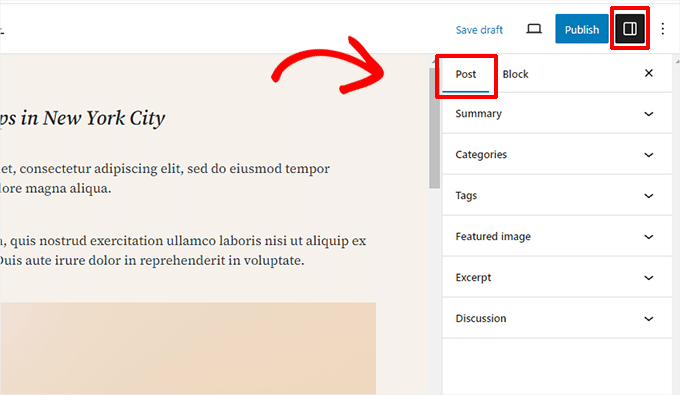
Plugin-Optionen in Gutenberg
WordPress-Plugins können die Vorteile der API des Blockeditors nutzen, um ihre Einstellungen in den Bearbeitungsbildschirm zu integrieren.
Einige beliebte Plugins verfügen über eigene Blöcke.
WPForms, das beste Plugin für WordPress-Kontaktformulare, ermöglicht es Ihnen zum Beispiel, Formulare mit Hilfe eines Blocks in Ihren Inhalt einzufügen.
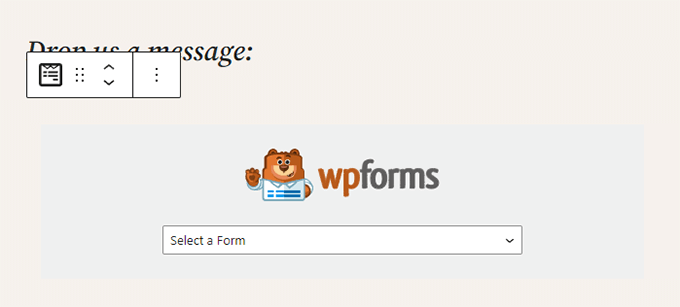
Auch andere WordPress-Plugins können ihre Einstellungen in den Block-Editor einfügen.
Hier sehen Sie zum Beispiel, wie Sie mit All in One SEO für WordPress Ihre SEO-Einstellungen unten im Block-Editor bearbeiten können:
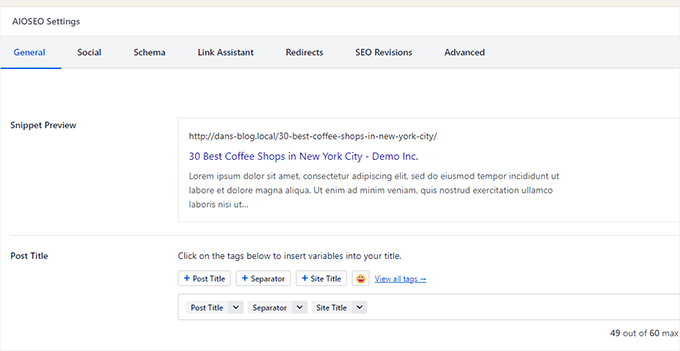
Wenn Sie ein Online-Geschäft mit WooCommerce betreiben, werden Sie feststellen, dass auch dieses seine eigenen Blöcke hat.
Mit diesen Blöcken können Sie Ihre Produkte zu jedem Ihrer WordPress-Beiträge und -Seiten hinzufügen.
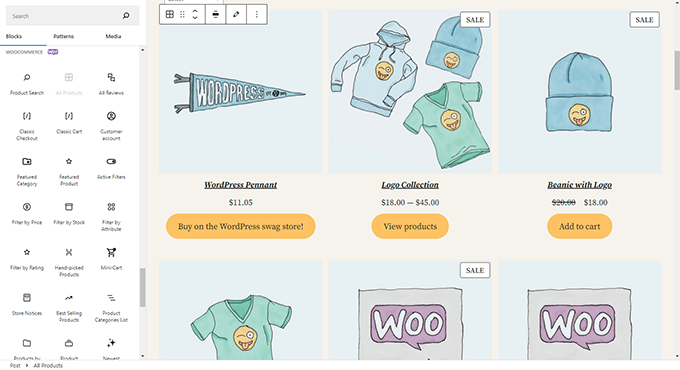
Hinzufügen einiger allgemeiner Blöcke im Block-Editor
Der Block-Editor kann alles, was auch der ältere klassische Editor konnte.
Allerdings werden Sie die Dinge schneller und eleganter erledigen als bisher. Und es kann noch viel mehr, z. B. können Sie Ihre Inhalte mit einer Reihe von Code-freien Optionen gestalten.
Hier sind einige der üblichen Blöcke, die Sie verwenden können.
1. Hinzufügen eines Bildes im WordPress-Block-Editor
Im WordPress-Block-Editor ist ein gebrauchsfertiger Bildblock vorhanden. Fügen Sie den Block einfach hinzu und laden Sie dann eine Bilddatei hoch oder wählen Sie sie aus der Mediathek aus.
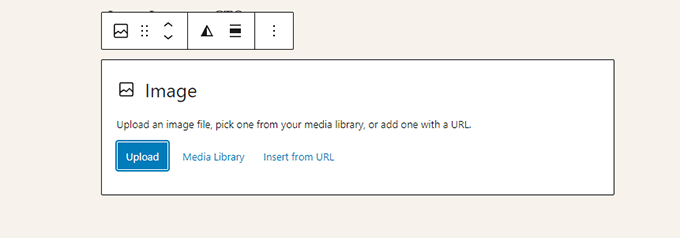
Sie können auch Bilder von Ihrem Computer ziehen und ablegen, und der Editor erstellt dann automatisch einen Bildblock.
Sobald Sie ein Bild hinzugefügt haben, sehen Sie die Blockeinstellungen, in denen Sie Metadaten für das Bild hinzufügen können, z. B. den Alt-Text, die Größe der Bildauflösung und das Hinzufügen eines Links zu dem Bild.
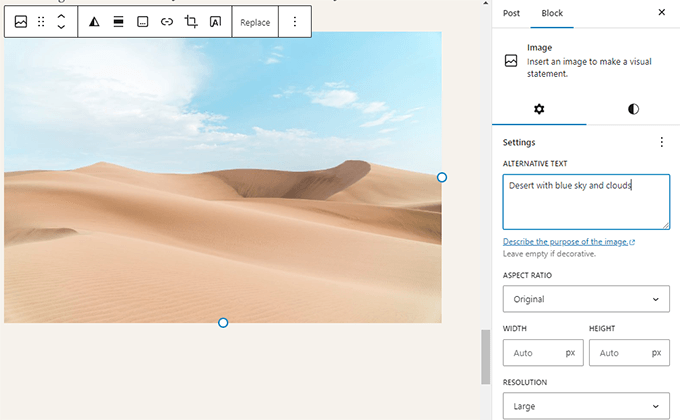
Weitere Informationen finden Sie in unserem Tutorial über das Hinzufügen von Bildern in WordPress.
2. Hinzufügen eines Links im Block-Editor
Der Block-Editor verfügt über mehrere Blöcke, in die Sie Text einfügen können. Der am häufigsten verwendete Block ist der Absatzblock, der in der Symbolleiste eine Schaltfläche „Link einfügen“ hat.
Alle anderen häufig verwendeten Textblöcke haben ebenfalls eine Verknüpfungsschaltfläche in der Symbolleiste.

Sie können einen Link auch mit der Tastenkombination Command + K für Mac und CTRL + K auf Windows-Computern einfügen.
3. Hinzufügen einer Bildergalerie in Gutenberg
Der Galerie-Block funktioniert wie der Bild-Block. Sie fügen ihn hinzu und laden dann Bilddateien hoch oder wählen sie aus.
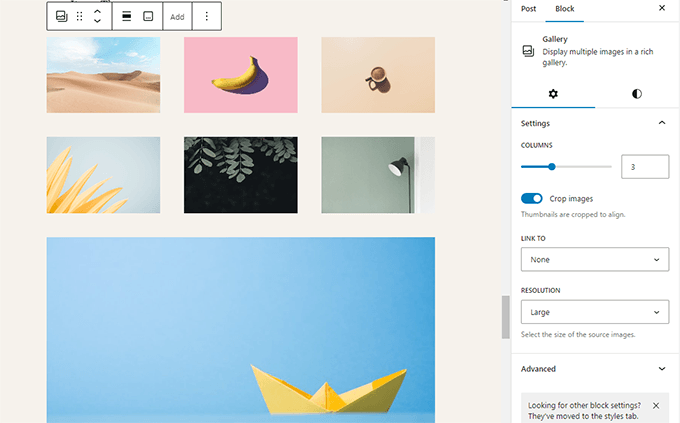
Weitere Einzelheiten finden Sie in unserem Leitfaden zur Erstellung einer Bildergalerie in WordPress.
4. Hinzufügen von Shortcodes in WordPress-Beiträgen mit Gutenberg
Alle Ihre Shortcodes funktionieren genau wie im klassischen Editor. Sie können sie einfach in einen Absatzblock einfügen oder den Shortcode-Block verwenden.
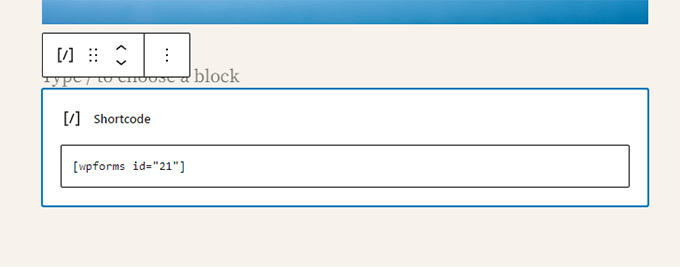
Andere Inhaltsblöcke im Block-Editor erkunden
Der Gutenberg Editor versprach, einige seit langem bestehende Usability-Probleme in WordPress durch die Einführung neuer Blöcke zu lösen.
Nachfolgend finden Sie einige der Favoriten, die unserer Meinung nach für die Nutzer sehr hilfreich sind.
1. Hinzufügen eines Bildes neben einem Text in WordPress
Viele unserer Benutzer konnten mit dem alten Editor kein Bild neben dem Text platzieren. Dies ist jetzt mit dem Block Medien & Text möglich.
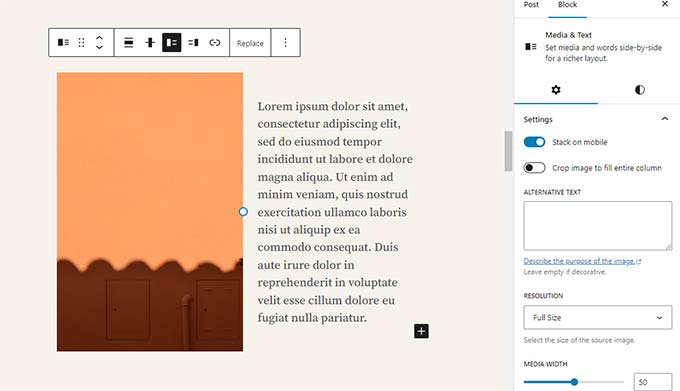
Dieser einfache Block besteht aus zwei nebeneinander angeordneten Blöcken, die es Ihnen ermöglichen, auf einfache Weise ein Bild mit etwas Text daneben einzufügen.
2. Hinzufügen einer Schaltfläche in WordPress-Beiträgen und -Seiten
Ein weiteres Ärgernis des alten Editors war das Hinzufügen eines Buttons zu Ihren Beiträgen oder Seiten im Blog. Sie mussten entweder ein Plugin verwenden, das einen Shortcode für den Button erstellt, oder in den HTML-Modus wechseln und Code schreiben.
Zum Glück gibt es in Gutenberg einen Button-Block, mit dem Sie schnell einen Button zu jedem Beitrag oder jeder Seite hinzufügen können.
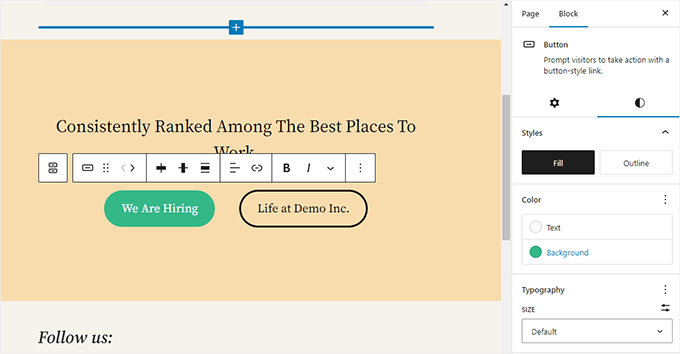
Sie können einen Link für Ihre Schaltfläche hinzufügen, Farben ändern und vieles mehr. Weitere Informationen finden Sie in unserem Artikel über das einfache Hinzufügen von Schaltflächen in WordPress.
3. Schöne Titelbilder in Blog-Posts und Landing Pages einfügen
Eine weitere coole Funktion, die Sie vielleicht ausprobieren möchten, ist der Cover-Block, mit dem Sie Cover-Bilder oder farbige Hintergrund-Cover zu Ihren Beiträgen und Seiten hinzufügen können.
Ein Titelbild ist ein breiteres Bild, das häufig für einen neuen Abschnitt auf einer Seite oder den Beginn einer Geschichte verwendet wird. Es sieht wunderschön aus und ermöglicht es Ihnen, ansprechende Layouts für Inhalte zu erstellen.
Fügen Sie einfach einen Cover-Block hinzu und laden Sie dann das gewünschte Bild hoch. Sie können eine Overlay-Farbe für das Cover wählen oder es als festes Hintergrundbild einrichten, um einen Parallaxen-Effekt zu erzeugen, wenn die Nutzer auf der Seite nach unten scrollen.
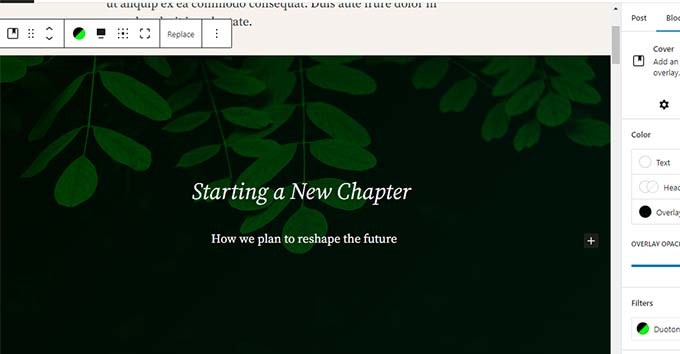
Weitere Einzelheiten finden Sie in unserem Artikel über den Unterschied zwischen Cover- und Featured-Bildern in WordPress.
4. Tabellen in Artikeln erstellen
Der klassische Editor verfügte nicht über eine Schaltfläche zum Hinzufügen von Tabellen zu WordPress-Beiträgen. Sie mussten ein Plugin verwenden oder eine Tabelle erstellen, indem Sie benutzerdefiniertes CSS und HTML schreiben.
Der Block-Editor verfügt jetzt über einen Standard-Tabellenblock, mit dem Sie ganz einfach Tabellen zu Ihren Beiträgen und Seiten hinzufügen können. Fügen Sie einfach den Block hinzu und wählen Sie die Anzahl der Spalten und Zeilen, die Sie einfügen möchten.

Sie können nun damit beginnen, Daten zu den Tabellenzeilen hinzuzufügen. Sie können bei Bedarf jederzeit weitere Zeilen und Spalten hinzufügen, und es stehen zwei grundlegende Optionen für die Gestaltung zur Verfügung.
5. Erstellen mehrspaltiger Inhalte
DasErstellen von mehrspaltigen Inhalten war ein weiteres Problem, mit dem der klassische Editor überhaupt nicht zurechtkam.
Glücklicherweise erlaubt der Block-Editor das Hinzufügen eines Spalten-Blocks, der zwei Absatz-Blockspalten hinzufügt.
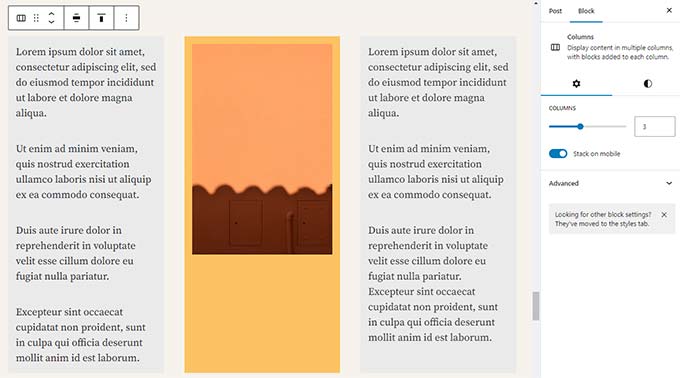
Dieser Spaltenblock ist sehr flexibel. Sie können bis zu 6 Spalten in einer Reihe hinzufügen und sogar andere Blöcke innerhalb jeder Spalte verwenden.
Bonus-Tipps zur Verwendung von Gutenberg wie ein Profi
Wenn Sie sich den Block-Editor ansehen, fragen Sie sich vielleicht, ob Sie mehr Zeit mit dem Hinzufügen und Anpassen von Blöcken als mit dem Erstellen von Inhalten verbringen werden.
Nun, der Block-Editor ist unglaublich schnell, und selbst wenn Sie ihn nur ein paar Minuten lang benutzen, können Sie sofort Blöcke hinzufügen, ohne auch nur darüber nachzudenken.
Schon bald werden Sie feststellen, wie viel schneller Ihr Arbeitsablauf mit diesem Ansatz wird.
Hier sind einige Bonustipps für Power-User, damit Sie noch schneller mit dem WordPress-Block-Editor arbeiten können.
1. Verschieben Sie die Blocksymbolleiste nach oben
In den obigen Screenshots haben Sie vielleicht bemerkt, dass oben in jedem Block eine Werkzeugleiste erscheint. Sie können diese Werkzeugleiste an den oberen Rand des Editors verschieben.
Um die Option „Obere Werkzeugleiste“ aufzurufen, klicken Sie auf den Button mit den drei Punkten in der rechten oberen Ecke der Ansicht.
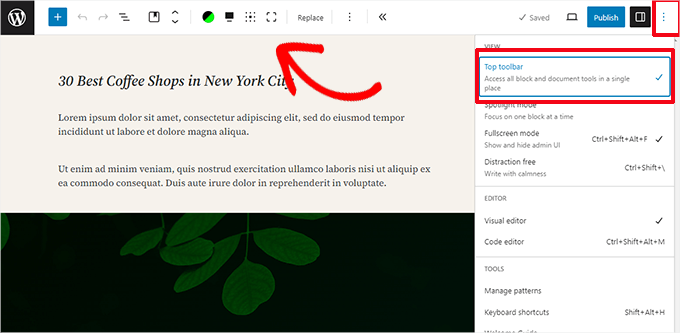
2. Tastaturkürzel verwenden
Gutenberg enthält mehrere praktische Shortcuts, die Ihren Arbeitsablauf noch schneller und einfacher machen. Die erste, die Sie sofort verwenden sollten, ist die /.
Geben Sie einfach / ein, beginnen Sie zu tippen, und der Editor zeigt Ihnen passende Blöcke an, die Sie sofort hinzufügen können.
Weitere Tastenkombinationen finden Sie, wenn Sie auf das Drei-Punkte-Menü in der oberen rechten Ecke Ihrer Ansicht klicken und „Tastaturkürzel“ wählen.
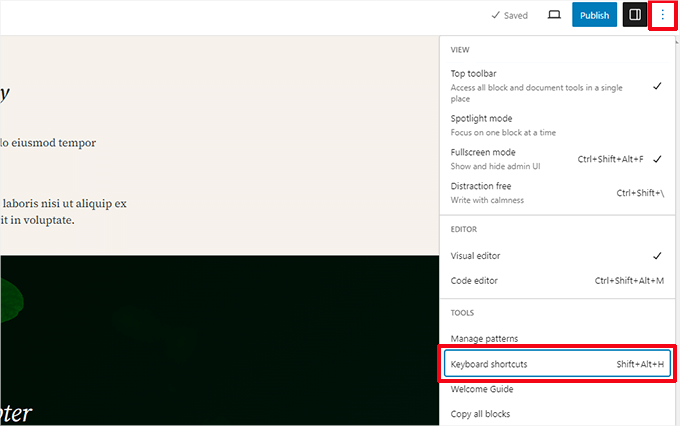
Daraufhin wird ein Popup-Fenster mit einer Liste aller Tastenkombinationen angezeigt, die Sie verwenden können. Die Liste enthält unterschiedliche Tastenkombinationen für Windows- und Mac-Benutzer.
3. Ziehen und Ablegen von Medien zur automatischen Erstellung von Medienblöcken
Mit Gutenberg können Sie Dateien per Drag-and-drop an eine beliebige Stelle auf der Ansicht ziehen und so automatisch einen Block erstellen lassen.
Sie können zum Beispiel eine einzelne Bild- oder Videodatei ablegen und der Block wird für Sie erstellt. Alternativ können Sie auch mehrere Bilddateien ablegen, um einen Galerie-Block zu erstellen.
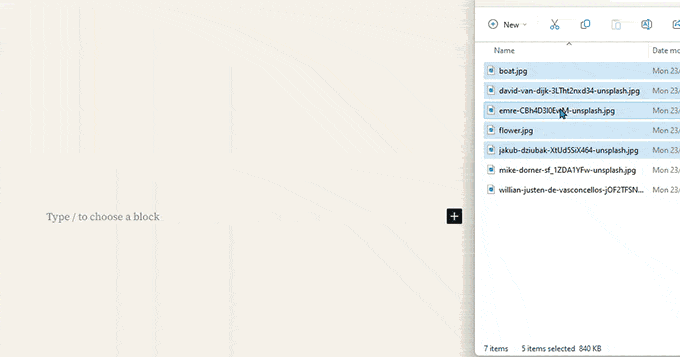
4. Hinzufügen von YouTube, Twitter, Vimeo und anderen Einbettungen
Der Block-Editor erleichtert das Einbetten von Inhalten Dritter in Ihre WordPress-Inhalte. Es gibt Blöcke für alle gängigen Dienste von Drittanbietern.
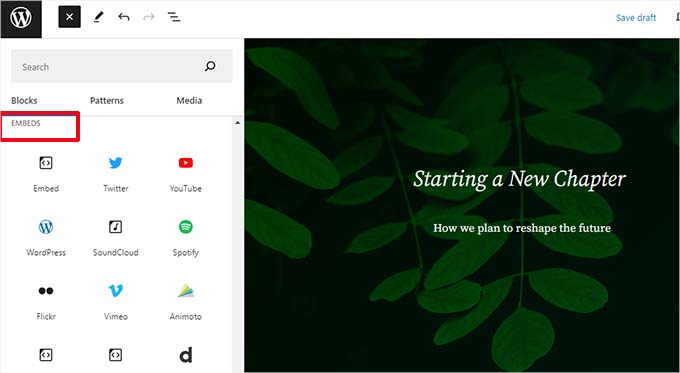
Sie können jedoch einfach die Einbettungs-URL kopieren und an beliebiger Stelle einfügen, und es wird automatisch ein Block für Sie erstellt.
Wenn Sie zum Beispiel die URL eines YouTube-Videos hinzufügen, wird automatisch ein YouTube-Einbettungsblock erstellt und das Video angezeigt.
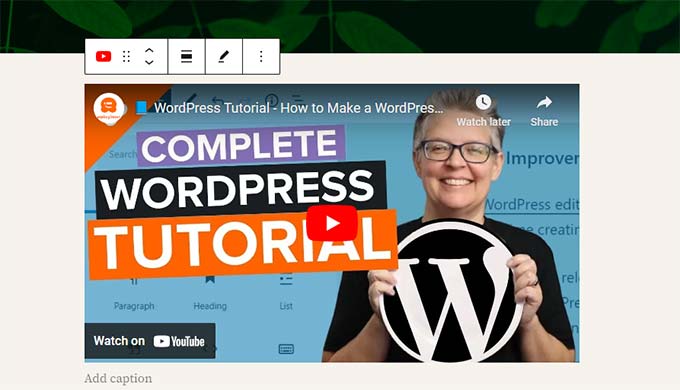
Die Standard-Einbettungsoption funktioniert nicht für Facebook- und Instagram-Einbettungen, aber es gibt einen Workaround. Siehe unseren Artikel zum Einbetten von Facebook- und Instagram-Beiträgen in WordPress.
Hinzufügen weiterer Blöcke zum Gutenberg-Block-Editor in WordPress
Der Block-Editor in WordPress ermöglicht es Entwicklern, ihre eigenen Blöcke zu erstellen. Einige hervorragende WordPress Plugins bieten Block-Pakete für den neuen Editor an.
Hier sind einige von ihnen:
1. Spectra WordPress Gutenberg-Blöcke

Spectra WordPress Gutenberg Blocks ist eine Block-Bibliothek mit vielen fortschrittlichen Blöcken, die Ihnen helfen, mehr Design-Elemente zu Ihrem Inhalt hinzuzufügen.
Spectra, erstellt von den Machern des beliebten Astra WordPress Themes, hilft Ihnen, schöne Designs zu erstellen, ohne Code zu schreiben.
Weitere Informationen finden Sie in unserem vollständigen Spectra-Test.
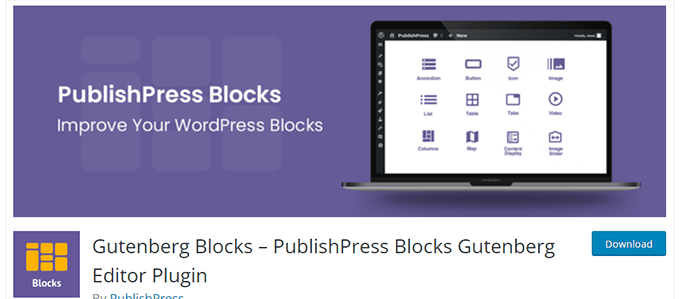
PublishPress Blocks ist eine weitere leistungsstarke Blockbibliothek, die zusätzliche Blöcke zur Erweiterung des Gutenberg-Blockeditors enthält.
Es umfasst wunderschöne Layout-Optionen, Schieberegler, Schaltflächen, Symbole, Bildergalerien, Karten, Registerkarten, Referenzen, Akkordeons und vieles mehr.
3. Stapelbar – Gutenberg-Blöcke
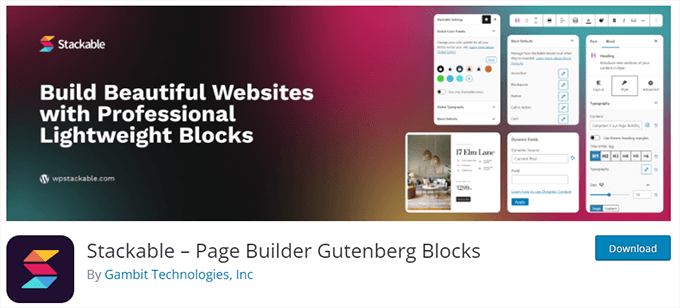
Stackable – Gutenberg Blocks ist eine Sammlung von wunderschön gestalteten Gutenberg-Blöcken, die Sie auf Ihrer Website verwenden können. Sie enthält Blöcke für den Container, Beiträge, Funktionen Raster, Akkordeon, Bild-Box, Icon-Liste, Aufruf zum Handeln, und mehr.
FAQs zu Gutenberg – Der Block-Editor in WordPress
Seit Gutenberg der Standard-WordPress-Editor ist, haben wir viele Fragen zur Verwendung des Editors erhalten. Hier sind die Antworten auf einige der am häufigsten gestellten Fragen über den Block-Editor.
1. Was passiert mit meinen älteren Beiträgen und Seiten im Blockeditor? Kann ich sie noch bearbeiten?
Der Block-Editor wirkt sich nicht auf Ihre alten Beiträge und Seiten aus. Sie können sie weiterhin bearbeiten, und der Block-Editor öffnet sie automatisch in einem Block, der den klassischen Editor enthält.
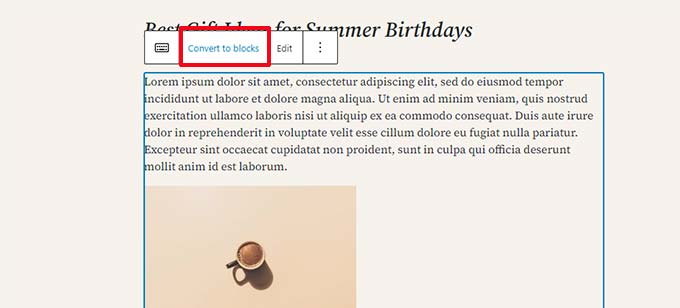
Sie können sie mit dem alten Editor bearbeiten oder ältere Artikel in Blöcke umwandeln und den Blockeditor verwenden.
2. Kann ich den alten Editor weiter benutzen?
Ja, Sie können weiterhin den alten Editor verwenden. Installieren und aktivieren Sie einfach das Classic Editor Plugin.
Nach der Aktivierung wird der Block-Editor deaktiviert, und Sie können weiterhin den klassischen Editor verwenden.
Bitte beachten Sie, dass der klassische Editor noch bis 2024 unterstützt wird. Um sich mit dem Block-Editor vertraut zu machen, sollten Sie ihn jetzt benutzen.
3. Was kann ich tun, wenn der Block-Editor mit einem von mir verwendeten Plugin oder Theme nicht funktioniert?
Das Projekt Gutenberg befand sich lange in der Entwicklung, so dass die Autoren von Plugins und Themes viel Zeit hatten, ihren Code auf Kompatibilität zu testen.
Es besteht jedoch immer noch die Möglichkeit, dass einige Plugins und Themes nicht gut mit dem Block-Editor funktionieren. In diesem Fall können Sie das Plugin für den klassischen Editor installieren, den Entwickler bitten, Gutenberg-Unterstützung hinzuzufügen, oder ein alternatives Plugin oder Theme finden.
4. Wie kann ich mehr über Gutenberg-Tipps und -Tricks erfahren?
WPBeginner ist der beste Ort, um etwas über den Block-Editor in WordPress zu erfahren. Wir sind die größte WordPress-Ressourcen-Website im Internet.
Wir werden neue Artikel veröffentlichen und unsere alten Ressourcen aktualisieren, um Ihnen zu helfen, den Block-Editor zu beherrschen.
Wenn Sie in der Zwischenzeit Fragen haben, können Sie uns gerne einen Kommentar hinterlassen oder das Kontaktformular auf unserer Website verwenden.
5. Haben Sie Probleme mit Gutenberg?
Wenn Sie Probleme mit dem Block-Editor von WordPress haben, haben wir eine Anleitung zur Problembehandlung erstellt, in der alle häufigen Probleme mit dem Block-Editor aufgeführt sind, auf die Benutzer stoßen, und wie man sie beheben kann.
Bonus-Ressourcen
Im Folgenden finden Sie einige zusätzliche Ressourcen, die Ihnen helfen, den Block-Editor effizienter zu nutzen:
- WordPress Block-Editor vs Page-Builder: Was ist der Unterschied?
- So erstellen Sie einen individuellen WordPress-Block (einfach)
- Wie Sie Ihre WordPress Gutenberg-Blöcke importieren / exportieren (2 Schritte)
- WordPress Widgets vs. Blöcke – Was ist der Unterschied? (Erläutert)
- Ein komplettes Einsteigerhandbuch für die vollständige Website-Bearbeitung mit WordPress
- Beste Block-Themes für die vollständige Website-Bearbeitung in WordPress
Wir hoffen, dass dieses Gutenberg-Tutorial Ihnen geholfen hat, den WordPress-Block-Editor zu nutzen. Vielleicht interessieren Sie sich auch für unseren vollständigen WordPress-Performance-Leitfaden zur Verbesserung der Geschwindigkeit Ihrer Website oder für unseren Vergleich der besten E-Mail-Marketingdienste für kleine Unternehmen.
Wenn Ihnen dieser Artikel gefallen hat, dann abonnieren Sie bitte unseren YouTube-Kanal für WordPress-Videotutorials. Sie können uns auch auf Twitter und Facebook finden.





ary
I have downloaded Gutenberg plug in but I still see the same classic editor. What I need to do?
WPBeginner Support
If your site is up to date it should be using the block editor by default, you would want to check if you have a plugin enabled to show the classic editor instead.
Admin
Jackson Ndawala
Is there a need for me to add a theme if the block editor can do all the things the theme can do? Please help.
WPBeginner Support
You would still need a theme for WordPress to work for the time being. The theme is for the overall design and styling of your site and you can use the block editor to customize parts of your site.
Admin
Cattie Coyle
I literally just heard about this new „Gutenberg thing“ and found your great tutorial – thank you, it will be super helpful once I figure out how to get Gutenberg to appear on my site. I still only have the classic editor (and I don’t have it as a plugin, it’s the way my site has always been), is there something I need to install to be able to see the Gutenberg editor?
WPBeginner Support
You would want to be sure your WordPress site is updated to the most recent version to see it. You would also would want to check if the classic editor plugin is active on your site for why the block editor is not your default editor.
Admin
jo gandomi
Hello
How did you change the background color of the editor?
For me it is white but for you it is a different color
WPBeginner Support
Unless your theme overrides this, the block editor should use the same background color as your content on your site.
Admin
Nikki
Thank you for the I’m informative video. I have been avoiding the new editor because I’ve been using WP for many years and didn’t see the usefulness in learning a new way when there was nothing wrong with the classic editor. I didn’t realize they were discontinuing classic in 2022, so I actually found this in perfect timing. I see there is still a bit of a learning curve, but it’s not as bad as I thought it would be.
WPBeginner Support
Glad our guide was helpful and we hope you enjoy using the new editor
Admin
Michael
This tutorial has really helped me understand what I can do using Glutenberg. Thanks
WPBeginner Support
Glad you found our guide helpful
Admin
Arnold
Hi there,
When I use the classic editor, the toolbar has a setting to choose a font-type from a drop down menu.
How do you change the font-type when using the block editor?
Arnold
WPBeginner Support
It sounds like you mean the Advanced Editor Tools (TinyMCE Advanced) you can add some of those tools back but for changing the font for your site’s visitors you would want to take a look at the recommendations from our article below:
https://www.wpbeginner.com/wp-themes/how-to-add-custom-fonts-in-wordpress/
Admin
Lio
For some mysterious reason the block settings show up below the page (like YoastSEO settings etc.) instead of on the right side of it. What could be the problem?
WPBeginner Support
More than likely your browser is too narrow, if you expand your browser window it should appear on the side again.
Admin
Jay
I am finding the block editor to be quite frustrating right now. This is because I was hoping to begin blog entries with a quote, poem, or song lyric. As I’m typing and hit enter to go to a different line in the poem, I get a new block. How can I do multiple lines without getting a new block for each line whenever I hit enter?
WPBeginner Support
You would want to use shift enter instead of only enter to stay within the same block.
Admin
Lisa Richardson
Finally decided to learn the block editor. Wow! Why did I wait so long? I read this article, then started a new draft page using block editor. So easy. Once I get used to it and learn more writing new pages and post will be so easy and fun! To those still using classic editor, you really need to start learning and using block editor.
WPBeginner Support
Glad you’re liking the block editor and we hope our guide can make the transition a little easier
Admin
Carla
I was wondering if there is a way to edit a block that has been used in multiple posts so that the changes would appear simultaneously?
WPBeginner Support
You would want to use a reusable block for what you’re wanting to do. You can see our guide on it below:
https://www.wpbeginner.com/beginners-guide/how-to-create-a-reusable-block-in-wordpress/
Admin
Marcel
why Gutenberg appears in the list of modules so that it can be installed if when you install WordPress the block editor is the default?
WPBeginner Support
There was a Gutenberg plugin for the block editor from before it was the default editor. You do not need to install the Gutenberg plugin to use the block editor anymore.
Admin
Naureen Amjad
Hi,
Thanks for the detailed article.
Some time ago, I deleted the block editor. How do I re-install it? there are so many Gutenberg plugins, can’t figure out which one is the default editor.
Thanks for your help.
WPBeginner Support
You would want to disable the Classic editor plugin to use the Block editor on your site normally unless you are using a different plugin.
Admin
Dana
Thank you! This was the answer I was looking for LOL. Couldn’t figure out why the block editor wasn’t showing. You all are the best.
Muhmmad Humayoon
Sir, I have to format my text spacing like margin and padding. Which block I should Use?
WPBeginner Support
That would be CSS rather than a specific block, for a starting point you would want to take a look at our guide on inspect element below:
https://www.wpbeginner.com/wp-tutorials/basics-of-inspect-element-with-your-wordpress-site/
Admin
James
Awesome. Very detailed and helpful.
WPBeginner Support
Glad our guide was helpful
Admin
Steve
What is the best way to copy content from MS Word into the Block Editor?
WPBeginner Support
You would want to take a look at our article covering this below:
https://www.wpbeginner.com/plugins/how-to-import-docx-documents-in-wordpress/
Admin
Ayoola Efunkoya
Nice and helpful post. However, I am seriously looking for resources on how to use the new editor with screen readers. Please can you help?
WPBeginner Support
We do not have a recommendation at the moment but we will keep a look out.
Admin
Russ
When I open my page and go to edit it, it ALWAYS first has the block editor tutorial pop up. How do I make this annoying pop up go away permanently so I can just get to my editing?
WPBeginner Support
You may want to ensure that your browser is not preventing cookies from being set when you close that popup for one common reason.
Admin
Sameo
From using this block editor, I realised that there is no way to send global font colour and size for the entire blog. It is super time consuming to change each individual blog.
Is there a way around this ?
WPBeginner Support
For that, you would need to use CSS. We cover CSS in our glossary page below:
https://www.wpbeginner.com/glossary/css/
Admin
Joshua
How do I reduce the visible post by putting ‚read more‘ where I want to keep hidden?
WPBeginner Support
For that, you would use the More block
Admin
Colin Burch
Is there a way to index a block? Reduce its width?
WPBeginner Support
It would depend on the specifics you are looking for when you say index. For the width, you can use CSS or columns as the most common methods for what you’re wanting to do.
Admin
Colin
I did not see something I have used often. Example is I have paragraph block where I describe a scripture reference. Then I make another paragraph block to contain the scripture. I would like to indent the scripture block. How would I do that?
WPBeginner Support
For the moment you should be able to use a classic block to add that indent
Admin
Colin
Thanks for reply. Actually, decided to use the ‚quote‘ block, though the ‚verse‘ block would also work. Both give a little indent. The ‚quote‘ puts a vertical bar also.
WPBeginner Support
Glad you found a solution that works for you
Nancy
I’m just starting out on Word Press. Maybe this was the „right“ time because I haven’t used the older version or gotten used to it. I’ll start right up w/ the new block editor. This guide was helpful. Thanks.
WPBeginner Support
You’re welcome, glad our guide could be helpful
Admin
Ted Owen
Thannks for such a wonderful article. And thanks for your patience. I tried Gutenberg for a brief period, but had difficulty with one important issue: images surrounded by text were right up against each other, no space at all. Tried to find a way to add padding, but couldn’t find it. So went back to Classic.
But now your article shows how much more there is good about Gutenberg, that I’ll just ask you–how do you add padding (space) between an image and abutting text? If there is a current resolution, will return to Gutenberg in a short minute!
Best, Ted
WPBeginner Support
You could use the media and text block for one method, you may also want to check with your theme’s support to ensure your theme’s styling isn’t part of the reason for this issue.
Admin
Ted Owen
Thank you. Will try it out next post.
Vatsalya Agnihotri
Sir your blog is amazing, I want to ask that if I want to mark my post as featured post in the block editor then how can I do that plz sir tell me
WPBeginner Support
There should be a checkbox in the post’s settings for sticking the post to the top of the blog for what it sounds like you want
Admin
macide
Hi,,Thank you veyr much for your article.
I was prejudiced against the new block editor at first but I am pleasantly surprised that it gives you many more option to transform your pages.
My only problem is that the block editors shows all titles in uppercase at the front end, though the titles on published posts look as they should. Is there any way to fix this so I can see what I’m doing on the editor ?
Thank you in advace.
WPBeginner Support
We do not have a recommendation at this time but as the block editor improves it should start to look more like the front end of your site.
Admin
Kathleen
I have WordPress dot com. I’m trying to use the block editor, but I can’t find where to enter tags and categories. It seems to have disappeared. Any tips? Thanks.
WPBeginner Support
That would be in the document settings, or you could check under the three verticle dots in the top right under options. Our tutorials are for self hosted installations so should the option not be available you would want to reach out to their support.
Admin
Shannon
is there a document that tells me what all these blocks do?
WPBeginner Support
Not at the moment.
Admin
Sarah
I NEED IT OFF AND I NEED IT OFF NOW. I don’t have plugins, I don’t understand. There is no option for classic / a normal editor. How do you go back on the free version? Any time I try to use any plugin even free ones it says I need to upgrade to a paid version of wordpress to use any, even the free plugins, bizarre.
WPBeginner Support
That would be due to your site being on WordPress.com, you are limited to their options for the classic editor as there are differences in WordPress.com and WordPress.org:
https://www.wpbeginner.com/beginners-guide/self-hosted-wordpress-org-vs-free-wordpress-com-infograph/
Admin
Dave Tolbert
Thanks for this article, it’s terrific. So far I like the block editor. But when I want to insert an image in a numbered list it seems that there is no control over where the image appears in the list. Is there a way to control where an image appears in a list block?
WPBeginner Support
If you’re having this issue with multiple blocks then you may want to try using a classic block for creating your list.
Admin
Neal Umphred
Thanks for this easy-to-follow tutorial on Gutenberg.
I just got to „Saving and Reusing Blocks in Gutenberg“ and followed all the steps. I reached the page where I can manage my reusable blocks.
Now, how do I get back to my editor?
WPBeginner Support
You would need to manually go back to the page through the posts/page admin area and edit the post again
Admin
Neal Umphred
Thanks—that is what I did!
Keep up the good work: This tutorial has helped me immensely in overcoming my fear of change from the Classic editor to the Gutenberg editor (a much more interesting and classy name that „block editor“).
PS: If you have an in with the Gutenbergers, you might suggest they add a return-to-editor option on that reusable page.
WPBeginner Support
GLad our article could help with your confidence in swapping to the new editor
Senchibald
Dear,
I have a problem with GUTENBERG block on wordpress. The block has suddenly become narrow, it is not all over the page and I do not have enough space. How to fix this problem?
WPBeginner Support
To start, if it is not a block added by a plugin, you would want to reach out to your theme’s support to ensure this isn’t a styling error in the theme.
Admin
Lily Girma
My blocks are all jumbled up when I try to create a new post and I can’t even write. Please help? I have everything updated so am not sure why it’s doing this. I am in Chrome.
WPBeginner Support
There are a few possible reasons, to start with you could try a different browser to see if an addon or similar is causing a problem. If that doesn’t fix the block location you could check for a theme or plugin conflict using our guide here: https://www.wpbeginner.com/beginners-guide/beginners-guide-to-troubleshooting-wordpress-errors-step-by-step/
Admin
Steve Smith
This new block system is awful.
I can’t do the basic of having a thumbnail image to the left and a h2 heading text centred inline at the top next to it with a h4 heading below.
This was the most basic of things to do with the old, superior system.
I have the illusion of more control but the reality is I have more options that achieve less.
I hope I can go back to classic style because this means i can’t add to my site anymore.
Just appalling.
WPBeginner Support
It is a learning process for the new editor, for what you’re wanting you may want to try the column block to create that.
Admin
Karen Fontaine
After reading the tutorial, and want to uninstall the plugin for classic editor. However, I have a post that was written in both classic and block–the fonts are different and it looks weird. When I switch to block view one of the blocks says „contains unexpected or invalid content“. And then asks to switch to HTML.
If I uninstall the plugin will I have to recreate this content?
WPBeginner Support
You will likely need to set up the content that was modified to HTML to get your styling back but for the most part, the content should still be there.
Admin
jill
is there a comprehensive list of the block symbols and what each one does?
WPBeginner Support
Not at the moment, as plugins add blocks there will also be more blocks in your list but the blocks should state their name below their symbol to give you an idea on what they’re used for
Admin
Annette Abrahamsen
This is a great intoduction! I’ve learned a lot..
However I can’t seem to find a guide on how to make a link block.
I need to link from my site to another site just using a block with a link.
The only option I get is to edit my permalink
Any ideas, you guys??
WPBeginner Support
When you edit text in a paragraph block by highlighting it, you should be able to use the small new toolbar to add a link.
Admin
DaveM
First started using WP V2.6 way back in 2008, and converted my own developed php sites, to use WP as a CMS. It’s certainly come a long way since then. While Gutenberg certainly seems to provide far better work-flow UI, which is packet with goodies, where once you either had to code yourself, or adopt a plugin, I must admit, even as seasoned WP user, the new interface has me stumped more often than not. It’s just another learning curve. So thanks for introduction, tips and guidance. I’ll use this inform to get handle on it! Cheers.
WPBeginner Support
Thanks for sharing how you feel about Gutenberg, as it improves hopefully it should get easier to use
Admin
Michael Lowing
I was pleased to find I could insert a table using the block editor. I populated the cells with codes each of which I wanted to link to media content. However, I could not see any easy way to do this. I could have linked to the URL in each case but this is long-winded. Obviously it would be better to be able to add media content directly from the block editor – have I been stupid and missed something?
WPBeginner Support
For the moment that is a limitation with the table block, the closest would be creating a column block to insert media blocks as another option.
Admin
Jonathan
Since I updated WordPress,I was alerted that „Connection lost“ I disabled classic editor plugin before it was resolved. Please is there any way I can use the classic editor and disable the Block editor. Since the block came, my WordPress app always notify me of Generic error when I publish. what is the problem of the app too?
WPBeginner Support
You would want to reach out to the app’s support and let them know about that issue for them to take a look into what could be the issue.
Admin
Curt Byers
This was an incredibly helpful tutorial.
But I don’t think I saw a solution to my inability to center title text. Which is ridiculous.
But the side bar format options you get with Headings, which have a CENTER option disappears with Title and the overhead format bar, which with Images has a CENTER option too. also disappears. This is the most important and visible feature on a page and WordPress has seemed to go out of its way to prevent a very common formatting choice. Any help? Thanks again for your service to the WordPress community.
WPBeginner Support
If you do not see the option to center the text then you should be able to click the three dots in the top right to enable the top toolbar. With that enabled, you should have the option to center the text in the paragraph block while the block is selected.
Admin
stephen hart
Is there an easy way to navigate between blocks on a page. For example if I am reading something in the first block on the page and next want to go to a block further down the page is there an easy way to jump to a different block or do you just have to scroll down the page?
WPBeginner Support
For the moment you would want to scroll down the page
Admin
Jeffrey Christian
I loathe the new formatting of WP, so much that I am changing my blog host. This is not more user friendly. I used to be able to post easily, then add a video from my library. Now, it defaults to the new block format, which is dreadful, and which I can’t change, and when I frustratingly finish the blog post, I can’t add my video media. WP is always updating to make blogging a more infuriating experience. What a shame.
WPBeginner Support
If you would like to stay on WordPress there is the option to revert to the classic editor using the method in our article here:
https://www.wpbeginner.com/plugins/how-to-disable-gutenberg-and-keep-the-classic-editor-in-wordpress/
Admin
Nesdon
Although this infuriating problem is universal to all software UIs. It often feels like as soon as you get up on to the flat part of the learning curve, they update the UI and throw another climb in your face.
I guess knowing how long to wait and how far to push design changes is the key to acceptance of progress among the user base. Indeed, Gutenberg is a tall step that some folks will not want to climb. But there were so many inscrutable legacy elements that they put off addressing for so long, it may have been unavoidable.
I’m struggling as well, especially dealing with older sites using lots of shortcodes, but hoping once I get over the hump, there will be a beautiful wide meadow on the other side.
Larry Dean
I think it would be useful to have the ability to save a group of blocks as one and not just the individual blocks. That way, once you have your post page like you want it, it can be reused. This would be particularly useful for those of us who don’t really change the structure of each post and don’t really need that degree of flexibility.
WPBeginner Support
That could certainly be something to look into for the future as Gutenberg improves
Admin
A O'Brien
Hi! Is there a way to change the size of a cover block? I want it to be a half page width so I can have two next to each other but can’t find anything to support this.
Thank you!
WPBeginner Support
You may want to use the column block for what it sounds like you’re wanting.
Admin
RK
Is there an option to disable blocks and revert back to the old editor format?
Gutenberg Block sucks, and I don’t want to compromise the quality and speed of my work while they spend the next couple of years improving it.
WPBeginner Support
You can revert to the classic editor using one of the plugins in our article here: https://www.wpbeginner.com/plugins/how-to-disable-gutenberg-and-keep-the-classic-editor-in-wordpress/
Admin
BOSS
The block is actually still rubbish. how to change block height??????
WPBeginner Support
The block editor is slowly trying to improve, your block should change its height based on the content added in the block
Admin
Danielle
I’m a total newb to WP and I am currently using the 2019 theme. All I’m trying to do is add an excerpt so that the full posts don’t show up on the home page. For the life of me I can’t figure out how to do this. I tried using the „excerpt“ text box found in the right nav of the document editor. Any help here would be great. Thanks!
WPBeginner Support
The theme may not support excerpts, you could try adding the more block or the read more depending on if you’re using the classic or block editor to see if that solved the issue
Admin
David Brittan
Danielle, maybe you want the „More“ tool, listed under Layout Elements. It lets you add a „Continue reading“ link after the first (or whichever) paragraph of a post.
nick
Is there a way to reduce space between two blocks?
WPBeginner Support
If you mean on the front end of your site, you would normally need to edit that using CSS
Admin
Lori | Choosing Wisdom
When I look at my paragraph block I don’t see the same options as you’ve shown here. I can’t change the color of a font and there are preset colors in the color settings under custom styles for background colors. Is there something I need to turn on to access this option in the paragraph block?
WPBeginner Support
You shouldn’t need to enable anything, you may want to ensure a plugin or your theme isn’t removing these options
Admin